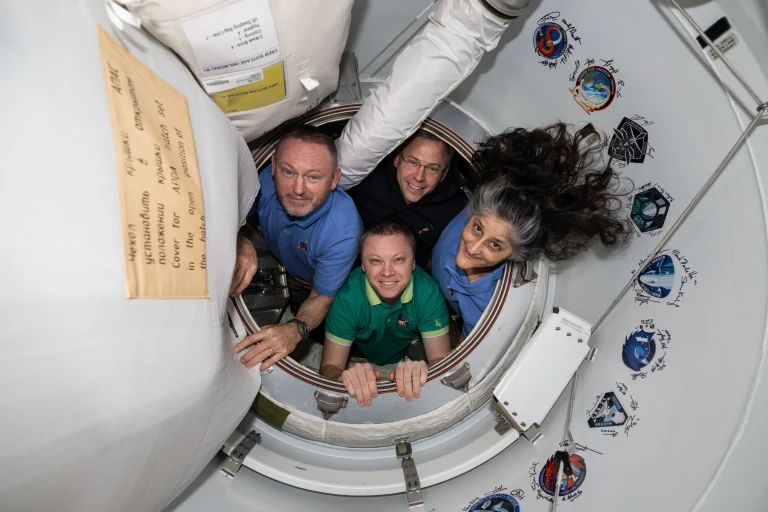This NASA/ESA Hubble Space Telescope image features a spiral galaxy, named UGC 10043. We don’t see the galaxy’s spiral arms because we are seeing it from the side. Located roughly 150 million light-years from Earth in the constellation Serpens, UGC 10043 is one of the somewhat rare spiral galaxies that we see edge-on.
This edge-on viewpoint makes the galaxy’s disk appear as a sharp line through space, with its prominent dust lanes forming thick bands of clouds that obscure our view of the galaxy’s glow. If we could fly above the galaxy, viewing it from the top down, we would see this dust scattered across UGC 10043, possibly outlining its spiral arms. Despite the dust’s obscuring nature, some active star-forming regions shine out from behind the dark clouds. We can also see that the galaxy’s center sports a glowing, almost egg-shaped ‘bulge’, rising far above and below the disk. All spiral galaxies have a bulge similar to this one as part of their structure. These bulges hold stars that orbit the galactic center on paths above and below the whirling disk; it’s a feature that isn’t normally obvious in pictures of galaxies. The unusually large size of this bulge compared to the galaxy’s disk is possibly due to UGC 10043 siphoning material from a nearby dwarf galaxy. This may also be why its disk appears warped, bending up at one end and down at the other.
Like most full-color Hubble images, this image is a composite, made up of several individual snapshots taken by Hubble at different times, each capturing different wavelengths of light. One notable aspect of this image is that the two sets of data that comprise this image were collected 23 years apart, in 2000 and 2023! Hubble’s longevity doesn’t just afford us the ability to produce new and better images of old targets; it also provides a long-term archive of data which only becomes more and more useful to astronomers.
Image Credit: ESA/Hubble & NASA, R. Windhorst, W. Keel
这张来自NASA/ESA哈勃太空望远镜的图像展示了一个被命名为UGC 10043的螺旋星系。由于我们是从侧面观察这个星系,因此看不到其螺旋臂。UGC 10043位于距离地球约1.5亿光年的蛇夫座,是少数几个我们能以侧面视角观测到的螺旋星系之一。
从侧面视角看,星系盘看起来像是一条穿越太空的锐利线条,其显著的尘埃带形成厚厚的云带,遮挡了星系辉光的部分视野。如果我们能够飞到星系上方,从俯视角度观察它,就能看到这些尘埃分布在UGC 10043中,可能勾勒出它的旋臂。尽管尘埃遮挡了星系,一些活跃的恒星形成区仍然穿透黑暗尘云发出亮光。此外,我们还能看到星系中心有一个发光的、几乎呈卵形的“核球”,从盘面上方和下方高高隆起。所有的螺旋星系都有类似的核球作为其结构的一部分。这些核球包含的恒星沿着星系盘上方和下方的轨道绕星系中心旋转;但在星系的图像中,这一特征通常不太明显。UGC 10043的核球相较其星系盘显得异常大,这可能是因为它从附近一个矮星系吸收了物质。这也可能是它的星系盘看起来扭曲的原因——一端向上弯曲,另一端向下弯曲。
与大多数全彩哈勃图像一样,这幅图像也是一幅合成图,由哈勃在不同时间拍摄的多张快照组成,每张快照拍摄到的光波长各不相同。这张图像的一个显著特点是,其组成的两组数据间隔23年收集——分别在2000年和2023年完成!哈勃的长寿不仅使我们能够对旧目标拍摄出新的、更清晰的图像,还为天文学提供了一个长期的数据档案,随着时间的推移,这些数据的价值变得越来越重要。
影像来源: ESA/Hubble & NASA, R. Windhorst, W. Keel







